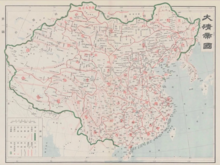

The Qing dynasty in Inner Asia was the expansion of the Qing dynasty's realm in Inner Asia in the 17th and the 18th century AD, including both Inner Mongolia and Outer Mongolia, both Manchuria (Northeast China) and Outer Manchuria, Tibet, Qinghai and Xinjiang.
Wars were fought primarily against the Northern Yuan (before 1636) and the Dzungar Khanate (1687–1758). Even before the conquest of China proper (see Transition from Ming to Qing), the Manchus had established the Later Jin dynasty that controlled Manchuria (modern Northeast China as well as Outer Manchuria) and Inner Mongolia, with the latter being previously controlled by the Northern Yuan under Ligdan Khan.
After suppressing the Revolt of the Three Feudatories and the conquest of Taiwan as well as ending the Sino-Russian border conflicts in the 1680s, the Dzungar–Qing War broke out. This eventually led to Qing conquests of Outer Mongolia, Tibet, Qinghai and Xinjiang. All of them became part of the Qing Empire and were garrisoned by Qing forces, but they were governed through several different types of administrative structures[1] and also retained many of their existing institutions. Furthermore, they were not governed as regular provinces (until Xinjiang and Manchuria were turned into provinces during the late Qing period), but instead were supervised by the Lifan Yuan, a Qing government agency that oversaw the empire's frontier regions.
- ^ The Cambridge History of China: Volume 10, Part 1, by John K. Fairbank, p37